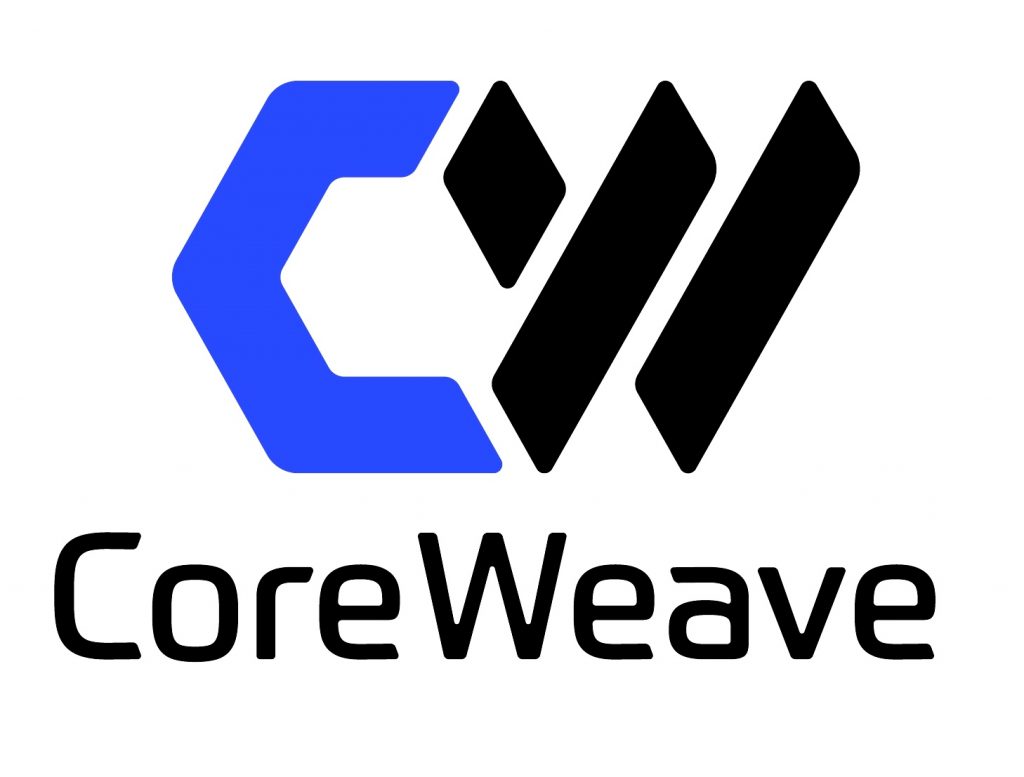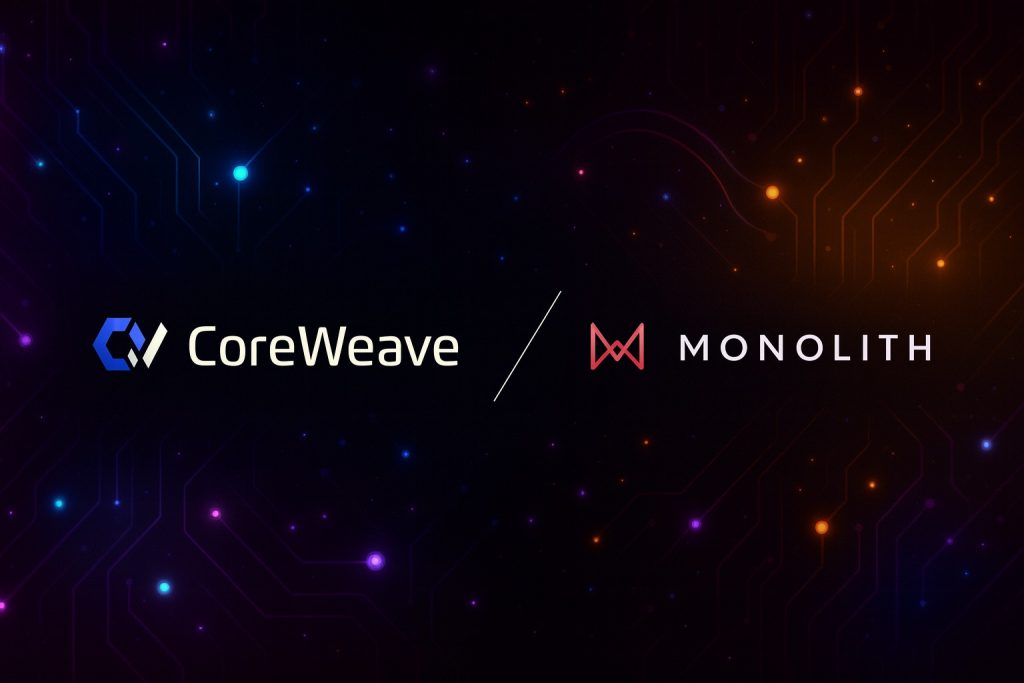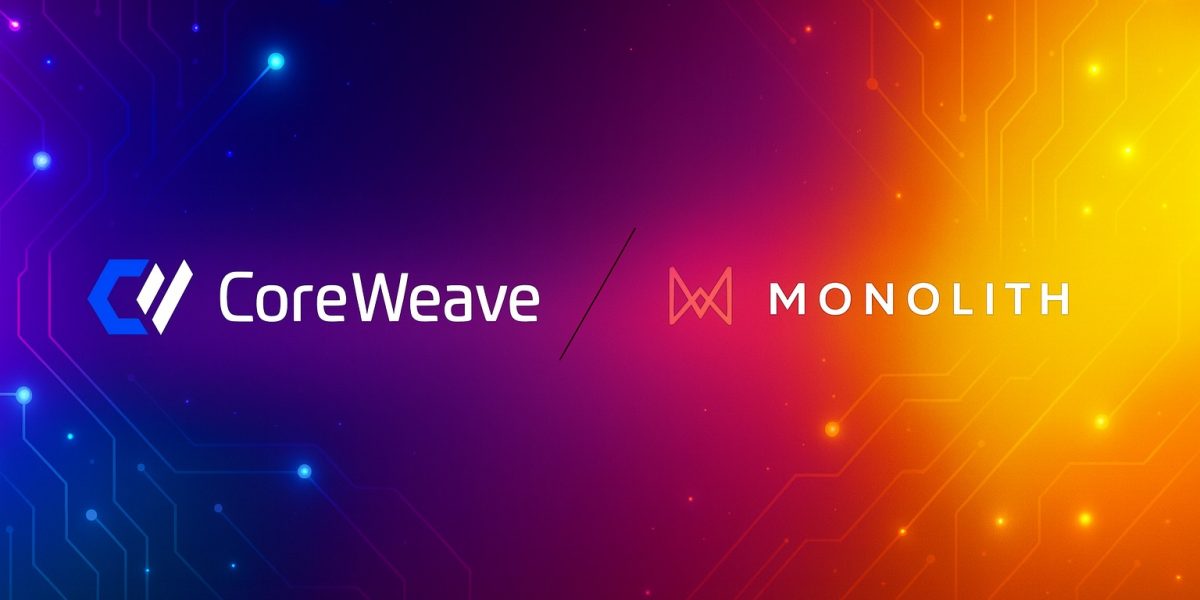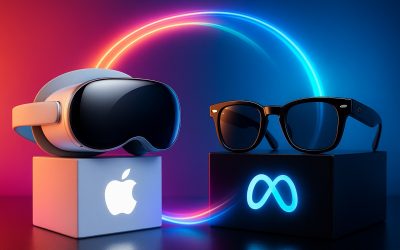CoreWeave announced on October 6, 2025, that it has reached an agreement to acquire Monolith AI Limited, a British company specializing in artificial intelligence and machine learning solutions for complex physical and engineering challenges. While the financial terms remain undisclosed, this transaction marks a significant strategic expansion for CoreWeave into industrial applications as the AI hyperscaler works to build a comprehensive platform for manufacturing enterprises.
The deal brings together Monolith’s capabilities in simulation and test-based machine learning with CoreWeave’s cloud AI infrastructure, creating what the companies describe as a full-featured platform for industrial and manufacturing operations. Monolith’s existing client roster includes major companies like BMW, Mercedes-Benz, Honda, Nissan, Honeywell, and Siemens.

Understanding CoreWeave’s First Application-Layer Move
This acquisition represents CoreWeave’s initial entry into the AI applications market, continuing a series of recent acquisitions that includes OpenPipe for reinforcement learning and Weights & Biases for model iteration and experiment tracking. Holger Mueller, an analyst at Constellation Research, noted that “This is CoreWeave’s first move into the AI applications market, and it could signal a potential future challenge related to workloads.”
Brian Venturo, CoreWeave’s co-founder and Chief Strategy Officer, emphasized the transformation opportunities for industry: “Every executive we meet in the industrial and manufacturing sectors knows that AI has the capability to transform their business. They need the right tools to use technology to solve the most complex problems in physics and engineering.”
What Monolith Brings to the Table
Monolith’s platform integrates machine learning directly into engineering workflows, offering tools for anomaly detection, test plan optimization, and next-test recommendations. The company’s technology enables substantial reductions in physical testing requirements—up to 73% according to research from Stanford, MIT, and the Toyota Research Institute. Test plan volumes can be reduced by as much as 70%.
How Machine Learning Changes Engineering Testing
Traditional engineering development relies heavily on physical prototyping and testing, which consumes significant time, resources, and materials. Monolith’s approach uses machine learning models trained on existing test data to predict outcomes for untested configurations, reducing the need for physical iterations while maintaining or improving design quality.
The platform’s anomaly detection capabilities help identify unusual patterns in test results that might indicate potential issues or opportunities for optimization. Test plan optimization determines which tests provide the most valuable information, eliminating redundant or low-value testing. Next-test recommendations guide engineers toward the most informative experiments based on what’s already been learned.
For automotive manufacturers like BMW and Honda—industries where physical crash testing, durability evaluation, and performance validation traditionally require extensive prototype development—these reductions translate directly into accelerated development cycles and substantial cost savings.
Market Timing and Financial Context
The timing aligns with substantial growth in AI adoption across manufacturing sectors. Research from McKinsey, referenced in the announcement, indicates that AI implementation in complex manufacturing can boost R&D efficiency by 20 to 80 percent. The global artificial intelligence in manufacturing market is projected to reach $155.04 billion by 2030, expanding at a compound annual growth rate of 35.3% from $34.18 billion in 2025.
CoreWeave’s stock increased 1% in post-market trading following the announcement, though the company’s shares had already surged 264% throughout the current year driven by major AI contracts, including a recent $14.2 billion agreement with Meta Platforms. The acquisition agreement remains subject to standard closing conditions, with Davis Polk & Wardwell LLP serving as CoreWeave’s legal counsel and Rothschild & Co acting as Monolith’s financial advisor.
Dr. Richard Ahlfeld, Monolith’s founder and CEO, stated that joining CoreWeave “will allow us to significantly scale our mission,” providing AI tools “to thousands of new creators from various industries who want to use AI but lack the infrastructure and expertise.”

Vertical Integration Strategy Taking Shape
CoreWeave’s acquisition pattern reveals a deliberate vertical integration strategy across the AI stack. The company started as an infrastructure provider focused on GPU compute resources for AI training and inference. Recent acquisitions extend capabilities into different layers:
OpenPipe acquisition: Added reinforcement learning capabilities, expanding the types of AI workloads CoreWeave can support beyond traditional supervised learning approaches.
Weights & Biases acquisition: Brought tools for model iteration, experiment tracking, and ML operations—critical capabilities for organizations developing and refining their own AI models.
Monolith acquisition: Provides the application layer with domain-specific solutions for manufacturing and engineering, demonstrating how CoreWeave’s infrastructure serves real-world industrial problems.
This vertical integration approach positions CoreWeave differently than pure infrastructure providers. Rather than simply selling compute capacity, the company can offer complete solutions combining infrastructure, development tools, and application-specific platforms. For enterprise customers, this integration potentially simplifies procurement, reduces integration complexity, and provides clearer paths from infrastructure to production applications.
Implications for Manufacturing AI Adoption
The acquisition addresses a significant barrier to AI adoption in manufacturing: the gap between generic AI capabilities and industry-specific requirements. Manufacturing companies face unique challenges around physical testing, material properties, complex simulations, and regulatory compliance that generic AI platforms don’t address directly.
Monolith’s existing relationships with automotive and industrial equipment manufacturers provide CoreWeave with immediate credibility and reference customers in these sectors. The client portfolio—BMW, Mercedes-Benz, Honda, Nissan, Honeywell, Siemens—represents some of the most sophisticated engineering organizations globally. Their willingness to adopt Monolith’s platform validates the approach and provides case studies demonstrating tangible results.
Competitive Landscape Shifts
CoreWeave now competes not just with other infrastructure providers like AWS, Google Cloud, and Azure, but also with specialized engineering simulation companies like Ansys, Altair, and Siemens Digital Industries Software. However, CoreWeave’s approach differs fundamentally—rather than competing directly with traditional simulation tools, Monolith’s machine learning platform complements them by learning from simulation and test data to accelerate the overall development process.
Traditional players in the engineering simulation market have also been adding AI capabilities, but typically through internal development or partnerships rather than acquisitions of established platforms with proven customer traction. CoreWeave’s move to acquire rather than build may accelerate its entry into this market compared to competitors developing capabilities organically.
Technical Integration Considerations
Combining Monolith’s machine learning platform with CoreWeave’s infrastructure presents both opportunities and integration challenges. Successful integration will need to address several technical dimensions:
Data pipeline integration: Manufacturing test data often resides in proprietary formats, specialized databases, and on-premises systems. Creating seamless data flows from customer environments to CoreWeave’s cloud infrastructure while maintaining security and compliance requires sophisticated integration capabilities.
Compute optimization: Monolith’s machine learning models need to take full advantage of CoreWeave’s GPU infrastructure without requiring customers to become experts in GPU programming or infrastructure optimization. Abstracting complexity while maintaining performance presents an ongoing technical challenge.
Existing customer migration: Monolith’s current customers likely run on various infrastructure providers. Migrating these workloads to CoreWeave’s platform—or providing hybrid deployment options—requires careful planning to avoid service disruptions and maintain performance levels customers expect.
Scale challenges: Dr. Ahlfeld mentioned serving “thousands of new creators from various industries.” Scaling from Monolith’s current customer base to thousands of users across multiple industries will test the platform’s architecture, support systems, and operational capabilities.
What This Means for Different Stakeholders
The acquisition creates different implications depending on your perspective:
For current Monolith customers: Access to CoreWeave’s infrastructure could improve performance and reduce costs compared to previous hosting arrangements. However, customers should seek clarity on any required migrations, potential service changes, and how existing contracts and pricing will be affected during the transition.
For manufacturing companies considering AI adoption: The combination of proven application-layer tools (Monolith) with robust infrastructure (CoreWeave) potentially lowers the barrier to entry compared to building custom solutions or cobbling together multiple vendors. The existing client portfolio provides reference points for evaluating potential value.
For CoreWeave competitors: This acquisition demonstrates that infrastructure-focused AI companies are moving up the stack into applications, potentially commoditizing pure infrastructure over time. Competitors may need to accelerate their own vertical integration or double down on infrastructure differentiation.
For engineering simulation incumbents: CoreWeave’s entry into manufacturing AI through acquisition signals increasing competition in a sector that has historically moved slowly to adopt cloud infrastructure and AI capabilities. Traditional players may need to accelerate their own AI integration and cloud migration strategies.
For investors evaluating AI infrastructure companies: The acquisition, combined with CoreWeave’s 264% stock performance this year and major contracts like the $14.2 billion Meta deal, demonstrates the company’s trajectory from pure infrastructure play to comprehensive AI platform provider. This vertical integration strategy could support premium valuations compared to pure infrastructure providers.
Analyzing the 73% Testing Reduction Claim
Monolith’s claim of up to 73% reduction in physical testing, based on research from Stanford, MIT, and Toyota Research Institute, deserves closer examination. Several factors influence whether specific organizations can achieve similar results:
Existing test data volume: Machine learning models require substantial training data. Organizations with extensive historical test databases can achieve better results than those with limited data. The automotive companies in Monolith’s client portfolio have decades of accumulated test data, providing rich training resources.
Problem complexity: Simple, well-understood engineering problems may not benefit as much from ML approaches since traditional methods already work efficiently. The most dramatic improvements typically occur in complex, multi-variable problems where traditional simulation struggles with computational demands or accuracy limitations.
Testing maturity: Organizations with systematic, well-documented testing processes can more easily train accurate models than those with inconsistent testing approaches or poor data quality. The reduction percentages likely reflect best-case scenarios with sophisticated engineering organizations.
Validation requirements: Regulatory industries like automotive and aerospace may still require certain physical tests regardless of ML predictions, limiting potential reductions. The 73% figure likely reflects scenarios where regulatory flexibility exists or where ML predictions can substitute for exploratory rather than validation testing.
Organizations evaluating Monolith’s platform should assess their own data assets, testing maturity, and regulatory constraints to develop realistic expectations for testing reduction in their specific contexts.

Looking Ahead: Integration Timeline and Market Impact
While CoreWeave and Monolith haven’t disclosed specific integration timelines, typical enterprise acquisitions in the technology sector follow predictable patterns:
Near-term (0-6 months): Integration planning, customer communication, and early technical integration work. Current Monolith customers should expect minimal changes during this period as the companies prioritize service continuity.
Medium-term (6-18 months): Technical platform integration, combined go-to-market initiatives, and expanded sales efforts leveraging CoreWeave’s enterprise relationships. This period will likely see the first joint customer wins combining CoreWeave infrastructure with Monolith applications.
Long-term (18+ months): Deeper product integration, potential platform extensions into adjacent manufacturing domains, and scaling to the “thousands of new creators” Dr. Ahlfeld mentioned. Success at this stage will demonstrate whether the acquisition achieves its strategic objectives.
Market Trajectory for Manufacturing AI
The projected growth from $34.18 billion in 2025 to $155.04 billion by 2030 represents a 35.3% compound annual growth rate—substantially higher than overall cloud infrastructure growth rates. This acceleration reflects several converging trends:
Supply chain pressures: Recent years demonstrated manufacturing vulnerability to supply chain disruptions. AI-powered simulation and optimization help companies develop more resilient, flexible manufacturing processes that can adapt to changing conditions.
Sustainability requirements: Reducing physical prototyping directly supports sustainability goals by decreasing material waste, energy consumption, and emissions associated with traditional development processes.
Time-to-market competition: In industries from automotive to consumer electronics, shorter development cycles create competitive advantages. AI tools that accelerate development without compromising quality become strategic assets.
Labor challenges: Many manufacturing sectors face skilled labor shortages, particularly in specialized engineering roles. AI tools that amplify engineer productivity help address these constraints.
CoreWeave’s entry into this high-growth market through the Monolith acquisition positions the company to capture value from these trends, assuming successful integration and execution.
Evaluating Strategic Fit
The Monolith acquisition appears strategically coherent for CoreWeave based on several dimensions:
Customer base alignment: Monolith’s enterprise manufacturing clients align well with CoreWeave’s focus on large-scale AI infrastructure contracts. These customers have significant compute requirements, long sales cycles, and high lifetime values—matching CoreWeave’s enterprise-focused business model.
Technical complementarity: Monolith’s machine learning platform creates natural demand for CoreWeave’s GPU infrastructure. Rather than acquiring capabilities that could run anywhere, CoreWeave acquired an application that benefits specifically from the high-performance compute resources CoreWeave provides.
Market positioning differentiation: Moving into applications helps differentiate CoreWeave from pure infrastructure competitors while the manufacturing focus provides a concrete vertical rather than attempting to serve all possible AI applications simultaneously.
Talent acquisition: Beyond the platform itself, CoreWeave gains a team with deep domain expertise in manufacturing AI, engineering workflows, and enterprise customer relationships in industrial sectors—capabilities that would take years to develop organically.
The acquisition makes strategic sense provided CoreWeave can successfully execute the integration and avoid the common pitfalls of technology acquisitions: cultural clashes, customer defection, key talent departure, and technical integration failures.
CoreWeave’s acquisition of Monolith AI marks a significant evolution in the company’s strategy, moving beyond pure infrastructure provision into domain-specific applications. The manufacturing and industrial engineering focus provides a concrete vertical with substantial growth potential, existing customer traction, and clear value propositions backed by research demonstrating meaningful reductions in testing requirements.
For the broader AI infrastructure market, this acquisition may signal a trend toward vertical integration as infrastructure providers seek differentiation and higher-value customer relationships beyond commodity compute capacity. The success or failure of CoreWeave’s integration and go-to-market execution will likely influence how other infrastructure providers approach similar strategic decisions.
Manufacturing companies evaluating AI adoption should monitor how the combined CoreWeave-Monolith offering develops, particularly around pricing, integration complexity, and demonstrated results beyond the existing customer base. The platform’s potential to dramatically reduce testing cycles and costs could justify significant investment for organizations with appropriate data assets and engineering maturity.
As the integration unfolds over the coming quarters, three key indicators will signal success: retention of existing Monolith customers, acquisition of new enterprise manufacturing clients leveraging the combined platform, and demonstrated performance improvements from infrastructure integration. These metrics will determine whether this acquisition delivers on its strategic promise or becomes another cautionary tale of technology integration challenges.




Post a comment